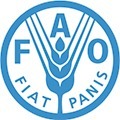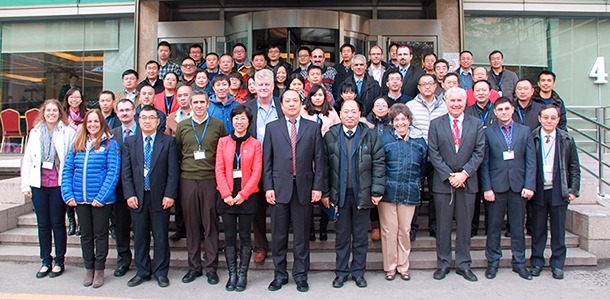 The situation of African swine fever (ASF), a deadly disease of pigs, has considerably worsened over the past years. In the traditionally endemic sub-Saharan Africa, the disease continues to spread into new areas. There is now a new open front in the Caucasus and Eastern Europe. The global ASF virus circulation, at its historical peak, has lead to the highest risk ever for the disease to enter into Asia, particularly China, home to almost half of the world’s pig population. An ASF epidemic in the region would have most catastrophic effects in the pork supply and protein availability worldwide. Over the past decade, China has developed very strong links with African countries through large investments and development projects, which translate into growing amounts of people and goods moving between Africa and China. Moreover, China shares border with the ASF-endemic Russian Federation. Given the historical freedom from ASF in China, awareness on the risk of introduction is low and the country was not fully prepared against an eventual incursion of the disease. To respond to this situation, an 18-month technical cooperation programme (TCP) project launched on 4 July 2014 was designed and implemented by FAO in collaboration with Veterinary Bureau, Ministry of Agriculture of China. The TCP aimed to assist China in the development of policy (ASF-specific contingency plans), capacity (clinical recognition, laboratory diagnosis and risk assessment) and awareness. The TCP was concluded with the organization of two back-to-back events in Beijing.
The situation of African swine fever (ASF), a deadly disease of pigs, has considerably worsened over the past years. In the traditionally endemic sub-Saharan Africa, the disease continues to spread into new areas. There is now a new open front in the Caucasus and Eastern Europe. The global ASF virus circulation, at its historical peak, has lead to the highest risk ever for the disease to enter into Asia, particularly China, home to almost half of the world’s pig population. An ASF epidemic in the region would have most catastrophic effects in the pork supply and protein availability worldwide. Over the past decade, China has developed very strong links with African countries through large investments and development projects, which translate into growing amounts of people and goods moving between Africa and China. Moreover, China shares border with the ASF-endemic Russian Federation. Given the historical freedom from ASF in China, awareness on the risk of introduction is low and the country was not fully prepared against an eventual incursion of the disease. To respond to this situation, an 18-month technical cooperation programme (TCP) project launched on 4 July 2014 was designed and implemented by FAO in collaboration with Veterinary Bureau, Ministry of Agriculture of China. The TCP aimed to assist China in the development of policy (ASF-specific contingency plans), capacity (clinical recognition, laboratory diagnosis and risk assessment) and awareness. The TCP was concluded with the organization of two back-to-back events in Beijing.
The ASF Prevention and Control Forum (25-26 November 2015)provided a platform for discussion and exchange the latest knowledge on ASF, its prevention and control, as well as to discuss the main challenges and opportunities for China. Participants included representatives from Veterinary Bureau, Chinese research institutions, provincial level veterinarians, and experts from external institutions. Chinese/English simultaneous translation was provided.

During day 1, an overview of ASF epidemiology, focusing on the situation and efforts in China, was presented by Wang Zhiliang, the leading scientist of China Animal Health and Epidemiology Centre (CAHEC). Luis Romero from the Ministry of Agriculture, Food and Environment (MAGRAMA), Spain, explained the process and key elements that allowed the ASF eradication in Spain after 35 years. The morning session was closed by Daniel Beltran-Alcrudo, FAO, who described the major international initiatives on ASF, focusing on FAO actions.
In the afternoon of day 1, Covadonga Alonso, from the Instituto Nacional de Investigaciones Agricolas (INIA), Spain provided an overview of the dynamics of ASF virus-host interactions, which helped as an introduction to the next talk, where Fernando Rodriguez, from the Centre de Recerca en Sanitat Animal (CReSA), Barcelona, Spain, presented promising advances done in the development of a potential attenuated vaccine against ASF. The day ended with a 40-minutes discussion session on the existing research initiatives on ASF in China, most importantly, the challenges in carrying out research on ASF in China..

During the morning of day 2, Beatriz Martinez Lopez, from the University of California-Davis, United States, introduced the topic of risk analysis, focusing on the new trends, such as big data1, real-time information platforms and personalized epidemiology2. Torsten Mörner, from the National Veterinary Institute (SVA), Sweden, covered the role of wild boar in ASF spread and maintenance, including the challenges (and solutions) of surveillance, prevention and control in these wild animal populations. Zhang Zhicheng, CAHEC, presented some preliminary risk assessment work done on ASF introduction into China. The morning session was closed by Klaas Dietze, Friedrich-Loffler-Institute (FLI), Germany, who presented on the challenges posed by backyard pig settings, including some practical solutions successfully applied elsewhere in the world.
The afternoon of day 2 covered the ASF status, prevention and control policies, as well as lessons learned in three regions/countries, i.e. Africa (by Mary-Louise Penrith, University of Pretoria), the Russian Federation (by Denis Kolbasov, National institute of veterinary virology and microbiology of Russia), and Poland (by Michal Popiolek, Animal Health and Welfare Office, General Veterinary Inspectorate, Poland). The meeting ended up with a second discussion session aimed, through a highly interactive process, at identifying the main challenges, advantages and potential introduction routes of ASF. The results of the discussions, served to draft the main recommendations to be presented at the Final Workshop the following day.
The Final Workshop took place on the morning of 27 November 2015. Participants included veterinarians from the different regions, representatives from CAHEC and CADC and the Veterinary Bureau (Ministry of Agriculture). Shuo Li (FAO China) presented on the main activities and achievements of the TCP, followed by the presentation and discussion of a list of recommendations for the Chinese authorities.
December 3, 2015 - FAO


